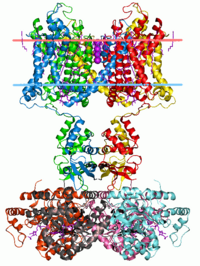
Photo from wikipedia
ABSTRACT Potassium Channel Interacting Protein 2 (KChIP2) is suggested to be responsible for the circadian rhythm in repolarization duration, ventricular arrhythmias, and sudden cardiac death. We investigated the hypothesis that… Click to show full abstract
ABSTRACT Potassium Channel Interacting Protein 2 (KChIP2) is suggested to be responsible for the circadian rhythm in repolarization duration, ventricular arrhythmias, and sudden cardiac death. We investigated the hypothesis that there is no circadian rhythm in QT interval in the absence of KChIP2. Implanted telemetric devices recorded electrocardiogram continuously for 5 days in conscious wild-type mice (WT, n = 9) and KChIP2−/− mice (n = 9) in light:dark periods and in complete darkness. QT intervals were determined from all RR intervals and corrected for heart rate (QT100 = QT/(RR/100)1/2). Moreover, QT intervals were determined from complexes within the RR range of mean-RR ± 1% in the individual mouse (QTmean-RR). We find that RR intervals are 125 ± 5 ms in WT and 123 ± 4 ms in KChIP2−/− (p = 0.81), and QT intervals are 52 ± 1 and 52 ± 1 ms, respectively(p = 0.89). No ventricular arrhythmias or sudden cardiac deaths were observed. We find similar diurnal (light:dark) and circadian (darkness) rhythms of RR intervals in WT and KChIP2−/− mice. Circadian rhythms in QT100 intervals are present in both groups, but at physiological small amplitudes: 1.6 ± 0.2 and 1.0 ± 0.3 ms in WT and KChIP2−/−, respectively (p = 0.15). A diurnal rhythm in QT100 intervals was only found in WT mice. QTmean-RR intervals display clear diurnal and circadian rhythms in both WT and KChIP2−/−. The amplitude of the circadian rhythm in QTmean-RR is 4.0 ± 0.3 and 3.1 ± 0.5 ms in WT and KChIP2−/−, respectively (p = 0.16). In conclusion, KChIP2 expression does not appear to underlie the circadian rhythm in repolarization duration.
Journal Title: Chronobiology International
Year Published: 2017
Link to full text (if available)
Share on Social Media: Sign Up to like & get
recommendations!